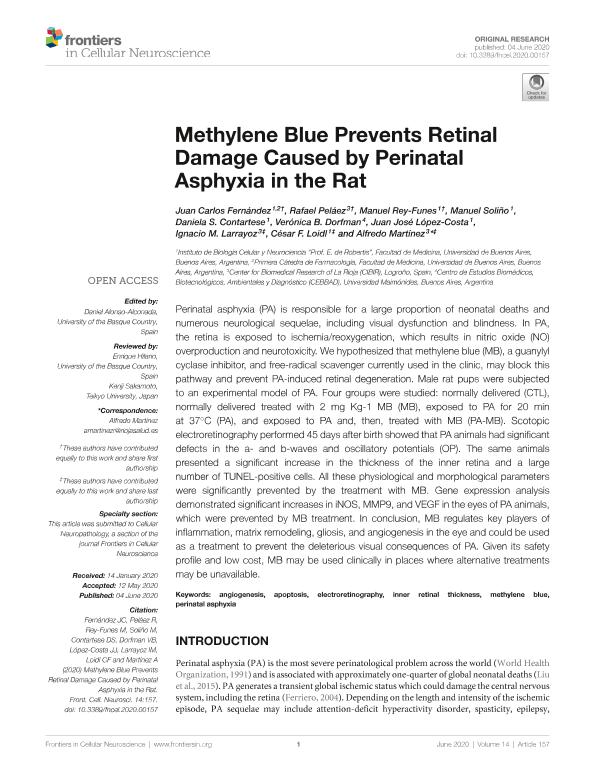Artículo
Methylene Blue Prevents Retinal Damage Caused by Perinatal Asphyxia in the Rat
Fernandez, Juan Carlos; Peláez, Rafael; Rey Funes, Manuel; Soliño, Manuel; Contartese, Daniela Soledad; Dorfman, Verónica Berta ; López, Juan José
; López, Juan José ; Larrayoz, Ignacio M.; Loidl, Cesar Fabian
; Larrayoz, Ignacio M.; Loidl, Cesar Fabian ; Martínez, Alfredo
; Martínez, Alfredo
 ; López, Juan José
; López, Juan José ; Larrayoz, Ignacio M.; Loidl, Cesar Fabian
; Larrayoz, Ignacio M.; Loidl, Cesar Fabian ; Martínez, Alfredo
; Martínez, Alfredo
Fecha de publicación:
06/2020
Editorial:
Frontiers Media S.A.
Revista:
Frontiers in Cellular Neuroscience
ISSN:
1662-5102
Idioma:
Inglés
Tipo de recurso:
Artículo publicado
Clasificación temática:
Resumen
Perinatal asphyxia (PA) is responsible for a large proportion of neonatal deaths and numerous neurological sequelae, including visual dysfunction and blindness. In PA, the retina is exposed to ischemia/reoxygenation, which results in nitric oxide (NO) overproduction and neurotoxicity. We hypothesized that methylene blue (MB), a guanylyl cyclase inhibitor, and free-radical scavenger currently used in the clinic, may block this pathway and prevent PA-induced retinal degeneration. Male rat pups were subjected to an experimental model of PA. Four groups were studied: normally delivered (CTL), normally delivered treated with 2 mg Kg-1 MB (MB), exposed to PA for 20 min at 37°C (PA), and exposed to PA and, then, treated with MB (PA-MB). Scotopic electroretinography performed 45 days after birth showed that PA animals had significant defects in the a- and b-waves and oscillatory potentials (OP). The same animals presented a significant increase in the thickness of the inner retina and a large number of TUNEL-positive cells. All these physiological and morphological parameters were significantly prevented by the treatment with MB. Gene expression analysis demonstrated significant increases in iNOS, MMP9, and VEGF in the eyes of PA animals, which were prevented by MB treatment. In conclusion, MB regulates key players of inflammation, matrix remodeling, gliosis, and angiogenesis in the eye and could be used as a treatment to prevent the deleterious visual consequences of PA. Given its safety profile and low cost, MB may be used clinically in places where alternative treatments may be unavailable.
Archivos asociados
Licencia
Identificadores
Colecciones
Articulos(IBCN)
Articulos de INST.DE BIOLO.CEL.Y NEURCS."PROF.E.DE ROBERTIS"
Articulos de INST.DE BIOLO.CEL.Y NEURCS."PROF.E.DE ROBERTIS"
Articulos(SEDE CENTRAL)
Articulos de SEDE CENTRAL
Articulos de SEDE CENTRAL
Citación
Fernandez, Juan Carlos; Peláez, Rafael; Rey Funes, Manuel; Soliño, Manuel; Contartese, Daniela Soledad; et al.; Methylene Blue Prevents Retinal Damage Caused by Perinatal Asphyxia in the Rat; Frontiers Media S.A.; Frontiers in Cellular Neuroscience; 14; 6-2020; 1-12
Compartir
Altmétricas



